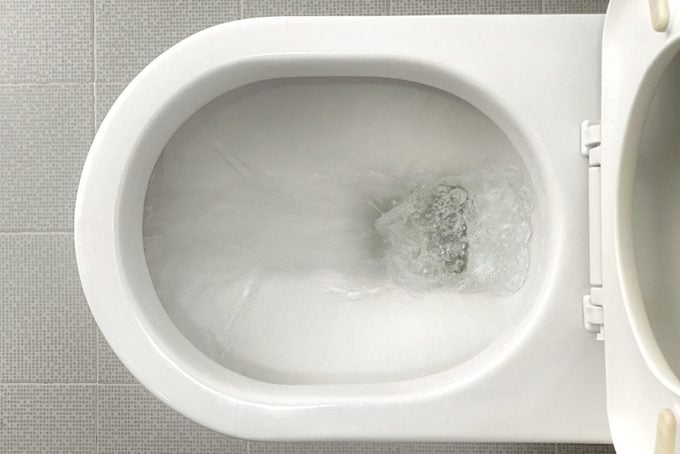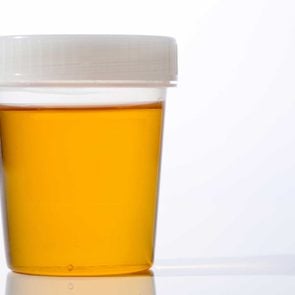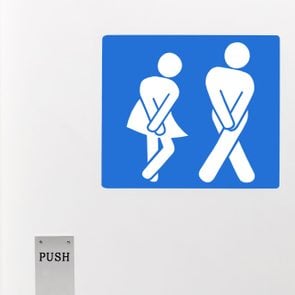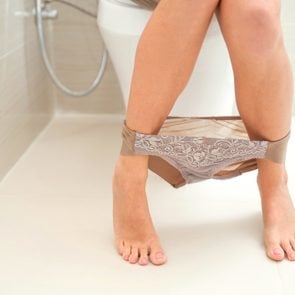6 Things That Can Cause Bright Yellow or Green Pee, from Urologists
Updated: Aug. 25, 2022
Do you have bright yellow, neon yellow, or green pee? Here are a few reasons this can happen, and what it means.
Do you have neon yellow or green urine?
You turn to flush the toilet and do a double-take—your urine is not exactly the pale-yellow shade you’ve come to expect. What’s going on?
Elizabeth Kavaler, MD—a double board-certified urologist and uro-gynecologist who is the director of Total Urology Care in New York City—says while urine is usually pale yellow, it can occasionally present as other colors, including bright yellow pee or even neon green pee. (Here’s a urine color chart that can help shed light on what those shades mean.)
Dr. Kavaler says urine color varies based on what you eat, how much water you drink, any medications or supplements you take, and any underlying health conditions. Here’s what you might want to know if you have bright yellow pee or green pee.
Here’s How Much Water You Really Need in a Day, with Nutritional Scientists’ Latest Wisdom
Where does urine come from, anyway?
The human urinary tract usually consists of two kidneys, two ureters, a bladder, and a urethra.
After the kidneys filter the blood to remove waste and excess fluid, the urinary tract produces urine that goes through the ureters, into the bladder, and finally through the urethra (the tube that carries urine out of the body).
Here’s How Much Protein You Really Need in a Day, with a Kidney Doctor’s Wisdom
Follow The Healthy on Facebook, Instagram, and Twitter
What is urine, anyway?
Dr. Kavaler says urine is mostly water, but it also contains salts such as sodium, potassium, chloride, uric acid, and urea. It should be pale yellow, clear, and free of clouds and particles.
Uric acid is a natural waste product from food digestion. Urea is also a waste product made of ammonia and carbon dioxide. The yellow color of urine is due to urobilin, a waste product and yellow pigment that’s generated from the breakdown of red blood cells.
However, urine isn’t always yellow, says Marisa Clifton, MD, assistant professor of urology and the director of women’s health at the Brady Urological Institute at Johns Hopkins Medicine in Baltimore, MD.
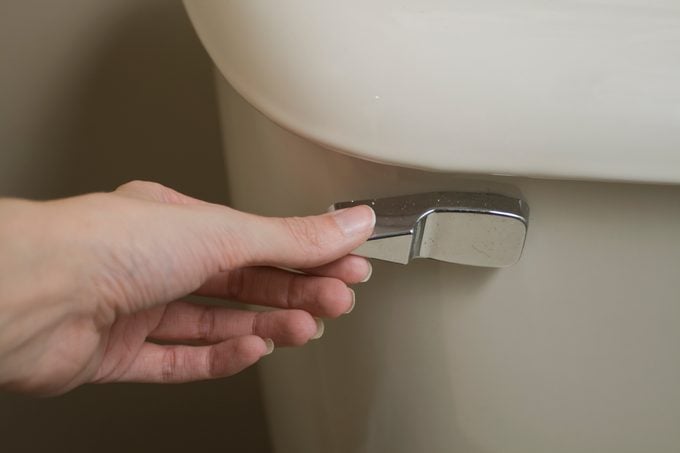
Why does my urine look neon yellow?
Vitamins and diet
If you ever popped too many gummy vitamins as a kid (no judgment, they were pretty tasty—but there is such thing as a gummy vitamin overdose), you may have noticed that your urine was bright yellow or even neon green.
The main culprits? B vitamins, such as riboflavin (B2) and cobalamin (B12).
Dr. Clifton says that multivitamins, even prenatal vitamins, certain meal replacement bars, and shakes may also be fortified with these B-vitamins and can also cause neon yellow or green pee.
This is generally harmless, and the excess B vitamins are mixed with urine and excreted naturally, adds Dr. Kavaler.
Other causes of bright yellow or bright green urine may include food dyes used in highly processed foods, she says—summing it up with this recommendation: if your urine is any of these colors, the first step is to look at your vitamin intake and the foods you’re eating.
Why is my urine dark yellow?
Dehydration
As you’ve possibly heard before, Dr. Clifton says darker shades of yellow and those bordering on amber may indicate that you’re not drinking enough water and are at risk for dehydration. The more water you drink, the clearer or lighter yellow the urine. If there isn’t enough water in your body, minerals and chemicals in your pee become more concentrated and darker in color.
Why is my urine green?
Diet
Some foods can turn urine a greenish color, too, Dr. Kavaler says. Asparagus, for example, can give your urine a greenish hue. (Eating asparagus is also one of the reasons your pee smells funny.)
UTIs
Bright green pee may be related to an excess of B-vitamins, but there are times that it can suggest a urinary tract infection (UTI), Dr. Clifton says, due to a bacteria called Pseudomonas. She adds that green pee is often just one of several symptoms: “Other UTI symptoms include pain and burning when urinating, along with frequency and urgency.” Another possible UTI symptom is blood in your urine.
Urine tests can help diagnose a UTI, and a course of antibiotics usually help to clear it up, Dr. Clifton says.
Medications
Certain medications may give urine a blue or green color. This includes the antidepressant amitriptyline, the pain reliever indomethacin, and the anesthetic Propofol.
Dyes used for some medical tests that look at kidney and bladder function can turn urine blue, Dr. Clifton says.
Check your urine every now and then
Dr. Clifton suggests it’s a good idea to look at your urine intermittently. If a change in color is also traveling with symptoms, or if it persists, it may be wise to see a doctor to find out what is going on.
Get The Healthy @Reader’s Digest newsletter
Keep reading:

